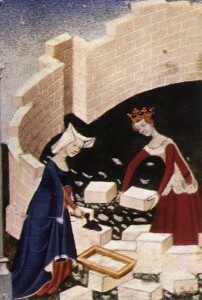InTrans / May 25, 2012
Historically Speaking: Women in construction
Go! Magazine
 posted on May 25, 2012
posted on May 25, 2012
Dating back to the 13th century, women’s contributions to construction have been largely disregarded. But, that doesn’t mean that weren’t doing it. In early history (i.e., the 13th through the 15th century), women were paid less and had fewer opportunities in construction than men. However, women could get some work, depending upon their social status.

According to scholars at the University of Texas at San Antonio1, single and very poor, married women could be given unskilled tasks on job sites including carrying water, digging ditches, thatching roofs, and mixing mortar. Middle-class women also sometimes worked with their fathers or husbands in trades such as masonry and carpentry. High-class women were sometimes given power over the design and management of construction projects, especially when they served as patrons of the project. Even so, women were discouraged from working in construction and most of their labor was not recorded. It was considered socially unacceptable for women to work outside the home, especially doing hard labor. For women, some acceptable occupations included sculpting, painting, and weaving tapestry, but construction was seen as nearly on par with prostitution.
Today, construction remains a non-traditional occupation for women, which ultimately means that women only make up 25 percent or less of all people employed in this field. However, social perceptions of women in construction have improved and opportunities have greatly increased. Since the 1960s, professional societies and unions have pushed to increase opportunities for women in construction and to address the issues that women might encounter on job sites. As of 2008, women’s presence in the workforce has grown to include 3.3 percent of all employed construction laborers and 8.2 percent of all construction managers.
As a result, there is still work to be done to make construction a more gender-equitable field, but women today can be seen fulfilling high-paid skilled labor and managerial positions in the construction industry. One prominent example is Kristine Young who in 2011 became the first woman president of the Association of General Contractors!

Citations
ascpro0.ascweb.org/archives/cd/2011/paper/CEGT353002011.pdf
By Alex Werner, Go! Staff Writer